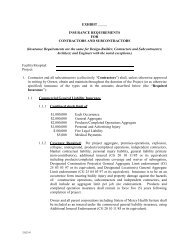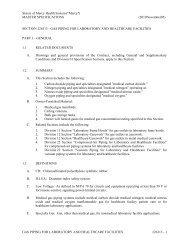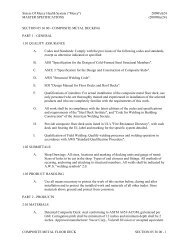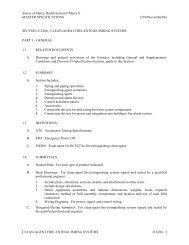Undescended Testes - Mercy
Undescended Testes - Mercy
Undescended Testes - Mercy
You also want an ePaper? Increase the reach of your titles
YUMPU automatically turns print PDFs into web optimized ePapers that Google loves.
<strong>Undescended</strong> TestisWhat is an undescended testis (cryptorchidism)?During the unborn male's development, the testicles (testes) are located in the abdomen and gradually move down into thescrotum. When they descend, they pass through a small passageway that runs along the abdomen near the groin called theinguinal canal. Once through the inguinal canal, the testes reside in the scrotal sac. Since the scrotal sac is cooler than thebody temperature, it is the ideal location for the testicles because they function better at this cooler temperature.<strong>Undescended</strong> testis and cryptorchidism refer to a condition in which the testicle has not descended and cannot be broughtinto the scrotum with external manipulation. This occurs in 3% of newborn males and up to 21% in premature malenewborns. Nearly three quarters of these move down on their own by the child's first birthday.The undescended testis can be located in the abdomen, the inguinal canal or other more unusual locations, but most arelocated in the inguinal canal (80%). About 10-15% of all cases are bilateral (involve both testicles).There is a genetic association with this condition. About 14% of boys with this condition come from families in which anothermale is affected also. Six percent of fathers of males with undescended testis have also had this problem.It is very important to clarify that "retractile testicles" are not undescended testicles. If a testicle can be brought down intothe scrotal sac, even if it retracts again upon release, it is a retractile testis. A reflex pulls the testicle up to protect it when theboy is cold or frightened. These retractile testicles are in the scrotum at other times and do not usually require treatment.DiagnosisThe discovery of an undescended testicle may be noticed by a child’s parents or by a pediatrician during a physicalexamination. Often, no testicle can be felt; this condition is called a non-palpable testicle (unable to be felt on examinationof the scrotal sac). Frequently, the exam shows an inguinal hernia (an area in the lower abdominal wall or inguinal canalwhere the intestines may protrude) as well.CauseIt is unknown why the testicles failed to descend. It may have been because the testicles were never normal at developmentor that there was problem that leads the testicles in the wrong direction.SymptomsThe undescended testicle does not cause pain. The scrotal sac may look smoother, smaller, or more flat than the unaffectedside.
ComplicationsIf an undescended testicle is not corrected, the following complications may occur as the male child grows and matures:InfertilityThe exposure of the testicle to the higher temperature of the body, when it is not in the scrotum, may impair the spermproduction. This is the most important concern and this risk increases when both testicles are undescended andorchidopexy is not performed during early childhood.MalignancyAn undescended testicle increases the risk of testicular cancer in adulthood. While the correction of the undescendedtesticle does not decrease the risk of cancer, it allows for the testicle to be properly examined in the future and earlydetection of cancer if it develops.TraumaA testicle that is trapped in abnormal position is more likely to be injured from trauma during ordinary activity.Testicular TorsionTesticular torsion is a painful condition where the testicle can twist and decrease its blood supply and eventually lead totesticular loss. This can occur more often in an undescended testicle.TreatmentThere are two treatment options hormonal and surgical.HormonalIn cases in which both sides are undescended, hormonal treatment may aid the testicles' descent into the scrotum. Thehormone human chorionic gonadotropin (hcg) is given as injections over several weeks. Although it is safe and successful inproving that retractile testes are down in the scrotum, it only cures undescended testes 10-15% of the time. Later, surgerymay still be indicated. Therefore, most parents prefer surgical treatment.SurgeryThere are several possible procedures to correct this condition depending upon the location of the testicle and thedistance to the scrotal sac.1. The Orchidopexy is an outpatient (patient does not need to stay in hospital) procedure which requires generalanesthesia. This is performed when the surgeon can palpate (feel) the testicle in the groin. A small incision (cut) is made inthe groin (area where the leg attaches to the body); the testicle is located, freed from restrictive tissues, positioned andanchored in the scrotum. The passageway is then stitched closed to prevent the testicle from moving out of the scrotum.
















